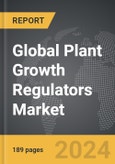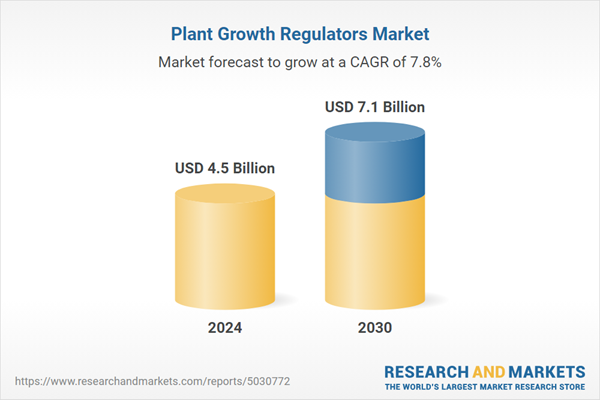The global market for Plant Growth Regulators was valued at US$4.5 Billion in 2024 and is projected to reach US$7.1 Billion by 2030, growing at a CAGR of 7.8% from 2024 to 2030. This comprehensive report provides an in-depth analysis of market trends, drivers, and forecasts, helping you make informed business decisions. The report includes the most recent global tariff developments and how they impact the Plant Growth Regulators market.
Segments: Type (Cytokinins, Auxins, Gibberellins, Ethylene, Other Types); Crop Type (Fruits & Vegetables, Cereals & Grains, Oilseeds & Pulses, Turf & Ornamentals).
Geographic Regions/Countries: World; United States; Canada; Japan; China; Europe (France; Germany; Italy; United Kingdom; Spain; Russia; and Rest of Europe); Asia-Pacific (Australia; India; South Korea; and Rest of Asia-Pacific); Latin America (Argentina; Brazil; Mexico; and Rest of Latin America); Middle East (Iran; Israel; Saudi Arabia; United Arab Emirates; and Rest of Middle East); and Africa.
The analysts continuously track trade developments worldwide, drawing insights from leading global economists and over 200 industry and policy institutions, including think tanks, trade organizations, and national economic advisory bodies. This intelligence is integrated into forecasting models to provide timely, data-driven analysis of emerging risks and opportunities.
Global Plant Growth Regulators Market - Key Trends and Drivers Summarized
Shaping Botanical Science: The Role of Plant Growth Regulators
Plant growth regulators (PGRs) are chemical substances that influence the growth and development of plants. These compounds, either naturally occurring or synthetically produced, play a crucial role in regulating various physiological processes such as cell division, elongation, flowering, fruiting, and senescence. The primary categories of PGRs include auxins, gibberellins, cytokinins, ethylene, and abscisic acid, each with distinct functions. Auxins, for instance, promote stem elongation and root initiation, while gibberellins are involved in seed germination and stem growth. Cytokinins stimulate cell division and shoot formation, whereas ethylene influences fruit ripening and abscisic acid regulates stress responses and dormancy. By modulating these growth processes, PGRs enable farmers and horticulturists to enhance crop yield, improve plant health, and manage plant development more effectively.How Are Plant Growth Regulators Utilized in Agriculture and Horticulture?
In agriculture and horticulture, plant growth regulators are invaluable tools for optimizing plant performance and productivity. Farmers use auxins to promote root development in cuttings and transplants, enhancing plant establishment and growth. Gibberellins are applied to increase the size of fruits such as grapes and to break seed dormancy in crops like barley. Cytokinins are used to delay leaf senescence in leafy vegetables, prolonging their market shelf life. Ethylene is often applied to synchronize fruit ripening in crops like tomatoes and bananas, ensuring a uniform harvest. Abscisic acid is used to improve plant resistance to environmental stressors such as drought and salinity. Additionally, PGRs are employed in ornamental horticulture to control plant height and shape, facilitating the production of aesthetically pleasing plants. Through these applications, plant growth regulators help improve crop quality, increase yields, and support sustainable agricultural practices.What Are the Current Trends in Plant Growth Regulator Research and Applications?
The research and application of plant growth regulators are evolving rapidly, driven by advancements in biotechnology and a deeper understanding of plant physiology. One significant trend is the development of novel PGR formulations that offer greater efficacy and environmental safety. Researchers are exploring the use of natural plant extracts and biostimulants as alternative sources of PGRs, aiming to reduce reliance on synthetic chemicals. There is also a growing interest in precision agriculture, where PGRs are applied using advanced technologies such as drone spraying and automated dosing systems, ensuring precise and efficient application. Another trend is the integration of PGRs with other agricultural inputs, such as fertilizers and pesticides, to create comprehensive crop management solutions. The use of PGRs in climate-resilient agriculture is gaining attention, with studies focusing on how these regulators can help crops withstand extreme weather conditions and other environmental stresses. These trends highlight the dynamic nature of PGR research and its potential to contribute to sustainable and productive agriculture.What Factors Are Driving the Growth in the Plant Growth Regulators Market?
The growth in the plant growth regulators market is driven by several factors, reflecting the increasing demand for enhanced agricultural productivity and sustainability. The rising global population and the consequent need to increase food production are significant drivers, as PGRs help improve crop yields and quality. Technological advancements in agriculture, including precision farming and biotechnological innovations, are enhancing the effectiveness and adoption of PGRs. The growing awareness of environmental sustainability is also propelling market growth, with an emphasis on reducing chemical inputs and improving crop resilience to climate change. Additionally, the expansion of the horticulture and floriculture industries, driven by consumer demand for high-quality ornamental plants, is boosting the use of PGRs. Regulatory support and government initiatives promoting sustainable agricultural practices further support market growth. These factors collectively ensure robust growth in the plant growth regulators market, highlighting their essential role in modern agriculture and horticulture.Report Scope
The report analyzes the Plant Growth Regulators market, presented in terms of units. The analysis covers the key segments and geographic regions outlined below.Segments: Type (Cytokinins, Auxins, Gibberellins, Ethylene, Other Types); Crop Type (Fruits & Vegetables, Cereals & Grains, Oilseeds & Pulses, Turf & Ornamentals).
Geographic Regions/Countries: World; United States; Canada; Japan; China; Europe (France; Germany; Italy; United Kingdom; Spain; Russia; and Rest of Europe); Asia-Pacific (Australia; India; South Korea; and Rest of Asia-Pacific); Latin America (Argentina; Brazil; Mexico; and Rest of Latin America); Middle East (Iran; Israel; Saudi Arabia; United Arab Emirates; and Rest of Middle East); and Africa.
Key Insights:
- Market Growth: Understand the significant growth trajectory of the Cytokinins segment, which is expected to reach US$2.9 Billion by 2030 with a CAGR of a 8.6%. The Auxins segment is also set to grow at 6.1% CAGR over the analysis period.
- Regional Analysis: Gain insights into the U.S. market, valued at $1.2 Billion in 2024, and China, forecasted to grow at an impressive 12.8% CAGR to reach $1.8 Billion by 2030. Discover growth trends in other key regions, including Japan, Canada, Germany, and the Asia-Pacific.
Why You Should Buy This Report:
- Detailed Market Analysis: Access a thorough analysis of the Global Plant Growth Regulators Market, covering all major geographic regions and market segments.
- Competitive Insights: Get an overview of the competitive landscape, including the market presence of major players across different geographies.
- Future Trends and Drivers: Understand the key trends and drivers shaping the future of the Global Plant Growth Regulators Market.
- Actionable Insights: Benefit from actionable insights that can help you identify new revenue opportunities and make strategic business decisions.
Key Questions Answered:
- How is the Global Plant Growth Regulators Market expected to evolve by 2030?
- What are the main drivers and restraints affecting the market?
- Which market segments will grow the most over the forecast period?
- How will market shares for different regions and segments change by 2030?
- Who are the leading players in the market, and what are their prospects?
Report Features:
- Comprehensive Market Data: Independent analysis of annual sales and market forecasts in US$ Million from 2024 to 2030.
- In-Depth Regional Analysis: Detailed insights into key markets, including the U.S., China, Japan, Canada, Europe, Asia-Pacific, Latin America, Middle East, and Africa.
- Company Profiles: Coverage of players such as ADAMA Agricultural Solutions Ltd., Arysta LifeScience Corporation, BASF SE, Bayer CropScience AG, Dow, Inc. and more.
- Complimentary Updates: Receive free report updates for one year to keep you informed of the latest market developments.
Some of the 31 companies featured in this Plant Growth Regulators market report include:
- ADAMA Agricultural Solutions Ltd.
- Arysta LifeScience Corporation
- BASF SE
- Bayer CropScience AG
- Dow, Inc.
- DuPont de Nemours, Inc.
- FMC Corporation
- Nippon Soda Co., Ltd.
- Nufarm Limited
- Syngenta AG
- Tata Chemicals Ltd.
- Valent BioSciences Corporation
- Xinyi Industrial
Tariff Impact Analysis: Key Insights for 2025
Global tariff negotiations across 180+ countries are reshaping supply chains, costs, and competitiveness. This report reflects the latest developments as of April 2025 and incorporates forward-looking insights into the market outlook.The analysts continuously track trade developments worldwide, drawing insights from leading global economists and over 200 industry and policy institutions, including think tanks, trade organizations, and national economic advisory bodies. This intelligence is integrated into forecasting models to provide timely, data-driven analysis of emerging risks and opportunities.
What’s Included in This Edition:
- Tariff-adjusted market forecasts by region and segment
- Analysis of cost and supply chain implications by sourcing and trade exposure
- Strategic insights into geographic shifts
Buyers receive a free July 2025 update with:
- Finalized tariff impacts and new trade agreement effects
- Updated projections reflecting global sourcing and cost shifts
- Expanded country-specific coverage across the industry
Table of Contents
I. METHODOLOGYII. EXECUTIVE SUMMARY2. FOCUS ON SELECT PLAYERSIII. MARKET ANALYSISCANADAITALYSPAINRUSSIAREST OF EUROPESOUTH KOREAREST OF ASIA-PACIFICARGENTINABRAZILMEXICOREST OF LATIN AMERICAIRANISRAELSAUDI ARABIAUNITED ARAB EMIRATESREST OF MIDDLE EASTIV. COMPETITION
1. MARKET OVERVIEW
3. MARKET TRENDS & DRIVERS
4. GLOBAL MARKET PERSPECTIVE
UNITED STATES
JAPAN
CHINA
EUROPE
FRANCE
GERMANY
UNITED KINGDOM
ASIA-PACIFIC
AUSTRALIA
INDIA
LATIN AMERICA
MIDDLE EAST
AFRICA
Companies Mentioned (Partial List)
A selection of companies mentioned in this report includes, but is not limited to:
- ADAMA Agricultural Solutions Ltd.
- Arysta LifeScience Corporation
- BASF SE
- Bayer CropScience AG
- Dow, Inc.
- DuPont de Nemours, Inc.
- FMC Corporation
- Nippon Soda Co., Ltd.
- Nufarm Limited
- Syngenta AG
- Tata Chemicals Ltd.
- Valent BioSciences Corporation
- Xinyi Industrial
Table Information
| Report Attribute | Details |
|---|---|
| No. of Pages | 277 |
| Published | April 2025 |
| Forecast Period | 2024 - 2030 |
| Estimated Market Value ( USD | $ 4.5 Billion |
| Forecasted Market Value ( USD | $ 7.1 Billion |
| Compound Annual Growth Rate | 7.8% |
| Regions Covered | Global |









